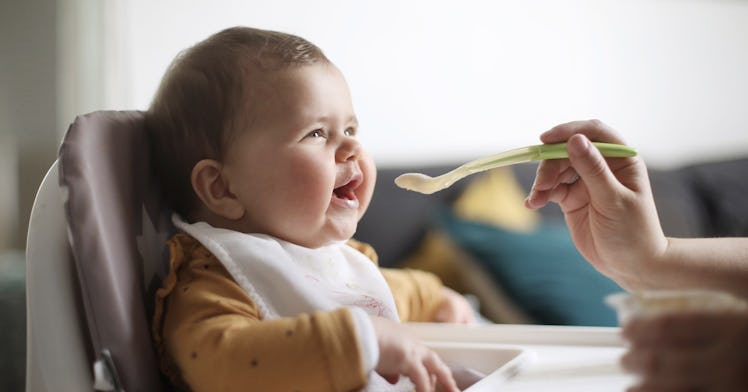Feeding Babies Is a Germy Mess. Here’s How Doctors Disinfect a Kitchen.
Doctors' disinfecting tips to help keep kids safe in the bacterial playground that is the average kitchen.

The following was produced in partnership with Lysol, which helps parents keep their homes clean and disinfected so they can be sure their babies are happy and comfortable at mealtime.
Babies are cute, not clean. This is especially apparent when it comes to the mealtime, a wild enjoyable mess that often ends in dumping a bunch of food on a tray table and letting it ride. Kids always end up eating, but the terms of ingestion are hard to negotiate and the forum for that negotiation — be it a high chair or a counter — generally ends up covered in debris. Sure, a kid covered in food mess is adorable, but food mess is still a problem.
That’s because many of the surfaces and objects used in preparation and feeding are bacteria breeding grounds. Disinfecting all hard surfaces is, therefore, a critical first step in the quest for a healthy and well-fed kid. According to Dr. Samuel Altstein, a board-certified primary care and family medicine physician at Mount Sinai Doctors in New York, the most basic thing parents can do to help prevent the spread of bacteria through a home is to wipe surfaces clean before and after preparing and eating food. “No food products, organic matter, or anything should be visible to the naked eye,” he says. Dr. Jennifer Trachtenberg, a fellow of the American Academy of Pediatrics echoes his sentiment, “I’ve said it a million times.”
That sounds easy, and it isn’t hard, but it does require an attention to detail and a willingness to repeat labor. First, thoroughly clean any surface where you intend to prepare and cook food. “Salmonella and E. coli, more than anything else, come into homes on foods and find areas to grow in kitchen surfaces,” says University of Arizona environmental microbiology professor Charles Gerba. That means cutting boards, too. “People don’t tend to disinfect it, but there’s more fecal bacteria on the average cutting board [primarily from meat preparation] than the average toilet,” Dr. Gerba grossly notes.
Next up, let’s not forget where we sit. “High chairs get grimy,” says Dr. Gerba. “They should get disinfected after every use. Not only the tray but also the seat because half the time they’re pooping in their diaper.” Gross. But, also, thanks. This is especially important for parents with more than one kid in diapers. “Diaper age kids will get ill more [due to their not-yet fully-formed immune systems] so keeping that area clean helps protect them as well as parents and other individuals.”
Finally, turn to the immediate area around a young eater. Because the kitchen is a high-activity zone and an ideal environment for bacterial growth, it’s scarily easy for an entire room to get contaminated, from the sink to the knobs on the cabinet to the fridge. “People tend to open the refrigerator door while cooking and contaminate the handle. Then they put a contaminated cleaning cloth or towel on that handle. And what’s the first thing small kids do when they come home from school? They run to the fridge and look for a snack,” he says. Clean that sucker every day.
Ok, now you know where you need to disinfect, but how? First of all, use a disinfectant that is approved for a food contact surface, not a wet sponge. The average kitchen sponge itself, it turns out, is a terrifying bacterial hellscape. Dr. Gerba would prefer parents never use one at all.
Then, take note of what cleaning chemicals you use and how you use them. Pure, concentrated bleach was a godsend to slowing the spread of disease in public places — but your kitchen isn’t a World War II-era field hospital (even if it might look that way at the end of pasta night). It should go without saying that keeping bleach and food separate is a healthy practice.
Instead, consider using a disinfectant that’s approved for food contact surfaces. New Lysol Daily Cleanser for example, is a simple three-ingredient disinfectant spray that’s approved for use on cutting boards, kitchen counters, and even pacifiers. It leaves behind no harsh chemical residue which means there’s no rinse step required. No harmful residue, plus, less time rinsing means more time capturing the hilarious facial expressions of babies eating lemons for the first time.
Finally, parents, please don’t forget your own germy selves. “It’s important that parents focus on the feeder,” says Dr. Altstein. “Infections are passed directly from person to person as well as from surface to person.” In other words? Before you take out your phone to snap a pic of your kid putting macaroni in their hair and grab those sweet, sweet likes, Dr. Altstein would like you to consider the last place you pulled out your phone, which is basically a portable petri dish. Oh, and wash your hands. Simple steps can make all the difference.
This article was originally published on